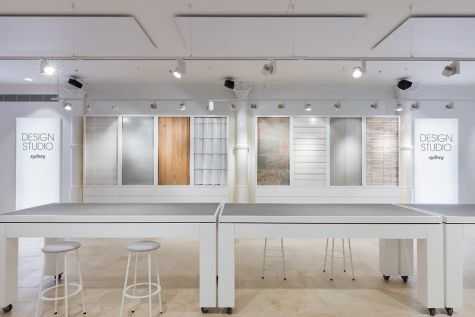
Whitton Lane
The designer abodes from developer Lindsay Bennalong, in collaboration with leading Australian firms Jackson Clements Burrows Architects (JCB) and DJRD Architects, are nestled in the western end of the effervescent suburb of Bondi Junction, beside the ambient Spring Street neighbourhood.
Exhibiting a contemporary take on brutalist form, the Whitton Lane building includes a collection of one-, two- and three-bedroom homes opportunely located within walking distance to both Bondi Junction’s famous retail hub and it’s more traditional low-rise residential village.

“The site is located in a dynamic part of Bondi Junction, surrounded by recent high-rise developments as well as an established heritage precinct including the Boot Factory and Norman Lee Place immediately opposite Spring Street,” explains Andrew Hipwell, Director of DJRD Architects.
The coveted locale formed the inspiration for building design. “Having established that strong connection to the heritage precinct, we opted to continue that dialogue in the choice of materials and design of the facades,” says Hipwell. “The precinct is characterised by conventional brick construction. Given we were constructing a different building type and scale, we explored ways in which brick could be used to visually connect while remaining distinct,” he adds.

The unadorned, monolithic appearance was a deliberate strategy to convey a feeling of strong, calm simplicity. “We drew on the rhythms and proportions of wall panels and openings of the Boot Factory to develop our facades language, even if by contrast,” Hipwell says.
Responding to the heritage-filled Boot Factory walls and plaza, the design team gave careful consideration to the brick selection. “It needed to have a strong tactile quality that is experienced at close quarters, for example on a balcony, and at the same time needed to provide a subtle, dynamic texture to the façade when seen from a distance,” Hipwell says. Over 500,000 San Selmo Grey Cashmere bricks were used to clad the building.
“The materials bring an inherent warmth and human scale often missing in large scale residential developments and would provide a point of difference for the development within the area,” says Hipwell. Articulated balconies finished in a contrasting material provide shadow play, and off-set the solidity of the brickwork.
Protruding window boxes are an unexpected design feature of the façade, providing an identifying feature from the street. “The overriding design principle was to create a timeless form with simplicity of expression,” Hipwell explains. “The window boxes are constrained in a repetitive grid across the façade, but have a subtle variation in the reversing of the sash opening floor to floor.”

Generously landscaped communal gardens, including the rooftop, offer insulation value to the structure, while providing a proper recreation space for residents. Passers-by certainly haven’t been neglected in the design, however.
“Other recent projects in the area have set up a through-site pedestrian network, and Whitton Lane had the unique opportunity to reinforce that network and utilise the public park and heritage Boot Factory opposite,” explains Hipwell. At Whitton Lane, the network is reinforced with a two-storey high continuous gallery and an open-to-the-sky plaza in the centre that brings light and ventilation, as well a sheltered place to pause.
“The paving tiles used in the through-site link have a brick scale and finish that is quite similar to the façade bricks,” he says. Large panels laid in simple, repetitive patterns ensure a visual continuity throughout the site.

- Italy – inspired, rustic and charming. The unique San Selmo range of Smoked, Reclaimed, Textured and Raw Corso embodies the beauty of brick. With hues that transition from light to dark, tactile finishes, and sizes from conventional to distinctive, the San Selmo range suits all contemporary projects and environments.
Learn about our products.
Join us at an event.




















